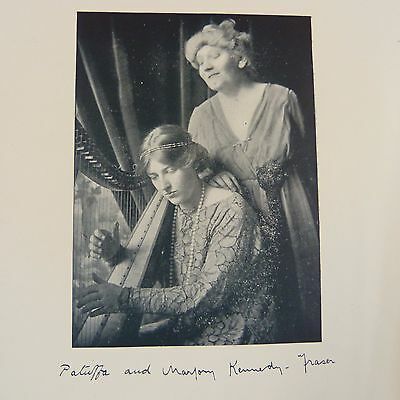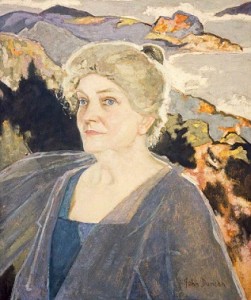Marjory Kennedy-Fraser (1857-1930) trascrisse e divulgò a livello internazionale molti canti in gaelico delle isole Ebridi.
Nel 1905 fece un viaggio nell’isola di Eriskay insieme all’amico pittore John Duncan e rimase affascinata dai canti in gaelico, che la gente tenacemente si tramandava di generazione in generazione.
Iniziò un progetto di registrazione (sui cilindri di cera come si usava allora) e di trascrizione/rielaborazione della musica delle Ebridi.
It was thanks to the work done by the Scottish singer Marjory Kennedy-Fraser (1857-1930) if many of the Hebrides songs were transcribed and became popular throughout Scotland and the world.
In 1905 she made a trip to the island of Eriskay with her friend, the painter John Duncan and got to know many songs in Scottish Gaelic, which the popular tradition tenaciously handed down from generation to generation, so she started a recording project (on the wax cylinders) and transcription of the Hebrides’ music.
Read the post in English
Questo lavoro di raccolta la portò negli anni successivi a visitare anche molte altre isole delle Ebridi. Tutto il lavoro venne pubblicato in tre volumi dal titolo “Songs of the Hebrides” (1909, 1917, 1921) (archivio digitale). Ai quali seguì un quarto volume “Songs of the Hebrides for voice and Celtic Harp or Piano” (1922) (la collezione in pdf qui) con partiture per pianoforte o arpa celtica, lo strumento suonato dalla figlia Helen Patuffa Kennedy-Fraser. Fu la figlia in particolare a viaggiare in Italia, Scozia e più in generale in Europa e negli Stati Uniti con la sua arpa celtica a diffondere le canzoni, collezionate dalla madre, in una serie infinita di concerti. (da ascoltare qui)
E qui colgo l’occasione per dire la mia sul lavoro svolto da madre e figlia (con l’aiuto del rev Kenneth Macleod per quanto riguarda i testi): sebbene Marjory Kennedy-Fraser nei suoi ripetuti soggiorni sulle Isole Ebridi abbia raccolto del materiale fonografico prezioso per l’etnomusicologia, tutto il materiale restituito sotto forma di pubblicazione, è stato pesantemente “arrangiato” secondo il gusto musicale “colto” e romantico del suo tempo, come pure i testi in gaelico scozzese sono stati “tradotti” in inglese e adattati sull’arrangiamento melodico.
Così facendo il carattere fresco, popolare o se vogliamo genuino del canto, lo spirito più “celtico” di quei canti e la loro poesia più spontanea, è andato perduto (spesso ma non sempre); perciò molti folkloristi bollano come “fasulla” tutta l’operazione (oggi si direbbe “commerciale”…)
Eppure credo che il suo sentimento sia stato sincero
Le canzoni trovate da Marjory Kennedy-Fraser rientrano in molte categorie: canzoni d’amore, ninne-nanne, canzoni da lavoro; canzoni sulle leggende e la storia dei Celti; e canzoni sul “rapimento del mare” in lode della bellezza della luce, delle nuvole e dell’oceano che si trovano nelle Ebridi.
Marjory fu aiutata nelle sue ricerche dallo studioso e poeta gaelico reverendo Dr Kenneth Macleod (1871-1955) nativo dell’isola di Eigg, che fornì testi e traduzioni. Altre melodie arrivarono dalla collezione del reverendo Patrick Macdonald, pubblicata nel 1784, e da Frances Tolmie (1840–1926), nata a Skye, la quale fu una prolifica collezionista di canzoni delle Isole Ebridi; un centinaio di melodie scozzesi vennero pubblicate dal Folk-Song Society (Journal of the Folk-Song Society, 16), materiale confluito nel libro di Ethel Bassin “The Old Songs of Skye: Frances Tolmie and her Circle”. 1997 che così scrive “Nel Journal la signorina Tolmie osserva che il suo piacere nelle canzoni di queste vecchie canzoni era considerato molto strano dai suoi contemporanei, “perché non erano considerate “poesie” o degne di nota dai collezionisti di canzoni di quel periodo’. Alcuni anziani, per fortuna, la pensavano come lei, in particolare sua zia, la signora Hector Mackenzie“
SONG OF THE HEBRIDES
English translation
This collection work took her in the following years to also visit many of the other islands. All the work was published with the English translation of Reverend Kenneth MacLeod in three volumes “Songs of the Hebrides” (1909, 1917, 1921) and in a fourth “Songs of the Hebrides for voice and Celtic Harp or Piano” (1922) (the collection in pdf here) with scores for piano or Celtic harp, the instrument played by daughter Helen Patuffa Kennedy-Fraser. It was her daughter in particular to travel to Italy, Scotland and more generally in Europe and the United States with her Celtic harp to spread the songs in an endless series of concerts. (to listen here)
Although Marjory Kennedy-Fraser in his repeated stays on the Hebrides has collected some phonographic material precious for ethnomusicology, all the material returned in the form of publication, was heavily “arranged” according to the musical “cultured” and romantic taste of the time, as well as the Scottish Gaelic texts were “translated” into English and adapted on the new melodic arrangement.
In doing so, the fresh, popular character, or if we want the genuine singing, the more “Celtic” spirit of those songs and their more spontaneous poetry, has been lost (often but not always); therefore many folklorists boil the whole operation as “fake” (today we would say “commercial” …) Yet I believe her feeling was sincere
The songs found by Kennedy-Fraser fall into many categories: love songs, cradle songs, work songs; songs about the legends and history of the Celts; and ‘sea-rapture’ songs in praise of the beauty of the Hebridean light, clouds and ocean. She was helped in her researches by the Gaelic scholar and poet the Reverend Dr Kenneth Macleod (1871–1955) who provided many of the texts and translations. Other airs came from the collection by the Reverend Patrick Macdonald, published in 1784, and from Frances Tolmie (1840–1926), born in Skye, who was a prolific folksong-researcher; by her one hundred of scottish melodies were published by the Folk-Song Society (Journal of the Folk-Song Society, 16), all merged into Ethel Bassin‘s book “The Old Songs of Skye: Frances Tolmie and her Circle“. 1997 which thus writes “In the Journal Miss Tolmie remarks that her pleasure in these old wive’s songs was considered very odd by her contemporaries, ‘for they were not deemed “poetry” or worthy of notice by song-collectors of that period’. Some of her elders, fortunately, were of her own way of thinking, notably her aunt, Mrs Hector Mackenzie (Annabella Tolmie)
A-Z Songs of the Hebrides

- AIGNISH ON THE MACHAIR
- AILEIN DUINN
- A PHIUTHRAG ‘S A PHIUTHAR (A Fairy Plaint)
- BEN OF JURA
- Birds at the fairy fulling (Ho, Fiream Forum Foirm)
- COCKLE GATHERER
- CUILLINS OF RUM
- ERISKAY LOVE LILT
- FAERIE’S LOVE SONG (THA MI SGITH)
- GRUAGACH-MHARA (The Seal-Maiden)
- Maighdeannan na h-àirigh/An Island Sheiling Song
- Islay Reaper’s Song (Buain A’Choirce)
- KISHMUL’S GALLEY
- MERMAID’S CROON
- PULLING THE SEA-DULSE
- SEA LONGING (AN IONNDRAINN MHARA)
- ROAD TO THE ISLES
- SEAL WOMAN’S SEA-JOY/ YUNDAH
- SEAL WOMAN CROON (AN CADAL TROM)
- Sea Tangle/The Sisters
- SKYE WATER KELPIE’S LULLABY
- THA SEATHAN AN-DIUGH NA MHARBHAN
- UIST CATTLE CROON
- WITCHERY FATE SONG
LINK
http://www.skyelit.co.uk/poetry/collect6.html
http://www.musicweb-international.com/bantock/budd.htm
http://www.raretunes.org/performers/patuffa-kennedy-fraser/
https://www.hyperion-records.co.uk/dc.asp?dc=D_CDA66988

